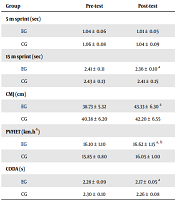Effect of Three Months Specific Training on Physical Capacities of Iraq Futsal Players
DOI:
https://doi.org/10.61838/kman.intjssh.6.1.3Keywords:
Team Sport, Athletic Performance, Iraq, SeasonAbstract
Background: Futsal is a high-intensity team sport taxing both the aerobic and the anaerobic pathways. Thus, this sport requires the development of some specific physical capacities such as: Sprinting, jumping, agility and endurance. Objectives: Examine the effect of three months specific training on physical capacities (speed, explosive strength, agility and endurance) of Iraq futsal players. Methods: Twenty males’ professional futsal players (age: 19.73 ± 1.1 years, height: 172 ± 4.2 cm; body mass: 55.3 ± 8.9 kg) were divided into an experimental group (EG; n = 10) and a control group (CG; n = 10). Participants were selected from a first division team in Iraq. Before and after three months of specific training (at the pre-season phase), 5m and 15m sprint, counter movement jump (CMJ), change of direction [505 agility test (CODA)] and futsal intermittent endurance (FIET) tests were realized. During the three months, the CG continue their usual training and the EG used plyometric as well as technical and physical exercises. Results: For the sprint performance, although no-significant difference was reported between pre- and post-training for the 5 m sprint, the 15 m sprint performance was better at post- compared to pre-training (P < 0.05) for the EG. For jumping performance, CMJ was higher at post- compared to pre-training (P < 0.05) for the EG. Likewise, for agility and endurance, CODA performance and peak velocity during the FIET test were better at post- compared to pre-training (P < 0.05) for the EG. However, except a better performance for 15m sprint and peak velocity during the FIET test for the EG compared to CG at post-training (P < 0.05), no-significant differences were reported between pre- and post-training for the CG and between the two groups at pre- and post-training. Conclusions: In the light of these data, results have shown that improvement in physical capacities take into consideration the characteristics of futsal during training.Downloads
Download data is not yet available.

Downloads
Additional Files
Published
2023-03-28
Issue
Section
Articles
How to Cite
Al-Azzawi, D. M. H., Halouani, J., Al-Gertani, A. O. S., & Chtourou, H. (2023). Effect of Three Months Specific Training on Physical Capacities of Iraq Futsal Players. International Journal of Sport Studies for Health, 6(1), 13-18. https://doi.org/10.61838/kman.intjssh.6.1.3




